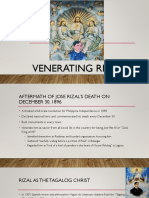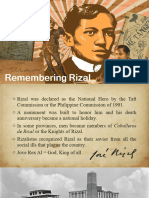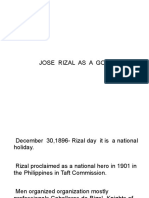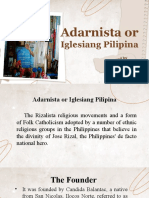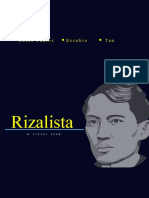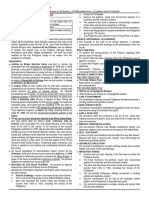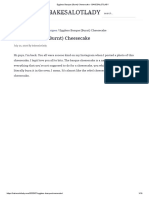0 ratings0% found this document useful (0 votes)
44 viewsSOCSC 005 Module 2
SOCSC 005 Module 2
Uploaded by
Yuan Kyle Santos- Jose Rizal is venerated by several religious groups in the Philippines who believe he is a god or the second coming of Christ. Some of the major groups include Iglesia Filipina Independiente, Adarnista, Sambahang Rizal, and Iglesia ni Cristo, with memberships ranging from 7,000 to 100,000.
- While Rizal is honored as a national hero, he has no official designation as the Philippines' national hero by law. However, American colonial governments promoted him as a hero of the revolution and he was declared the national hero by the Taft Commission in 1901.
- Rizal's execution in 1896 was a
Copyright:
© All Rights Reserved
Available Formats
Download as PDF, TXT or read online from Scribd
SOCSC 005 Module 2
SOCSC 005 Module 2
Uploaded by
Yuan Kyle Santos0 ratings0% found this document useful (0 votes)
44 views7 pages- Jose Rizal is venerated by several religious groups in the Philippines who believe he is a god or the second coming of Christ. Some of the major groups include Iglesia Filipina Independiente, Adarnista, Sambahang Rizal, and Iglesia ni Cristo, with memberships ranging from 7,000 to 100,000.
- While Rizal is honored as a national hero, he has no official designation as the Philippines' national hero by law. However, American colonial governments promoted him as a hero of the revolution and he was declared the national hero by the Taft Commission in 1901.
- Rizal's execution in 1896 was a
Original Description:
SOCSC 005 Handouts
Original Title
SOCSC 005 Module 2 PPT
Copyright
© © All Rights Reserved
Available Formats
PDF, TXT or read online from Scribd
Share this document
Did you find this document useful?
Is this content inappropriate?
- Jose Rizal is venerated by several religious groups in the Philippines who believe he is a god or the second coming of Christ. Some of the major groups include Iglesia Filipina Independiente, Adarnista, Sambahang Rizal, and Iglesia ni Cristo, with memberships ranging from 7,000 to 100,000.
- While Rizal is honored as a national hero, he has no official designation as the Philippines' national hero by law. However, American colonial governments promoted him as a hero of the revolution and he was declared the national hero by the Taft Commission in 1901.
- Rizal's execution in 1896 was a
Copyright:
© All Rights Reserved
Available Formats
Download as PDF, TXT or read online from Scribd
Download as pdf or txt
0 ratings0% found this document useful (0 votes)
44 views7 pagesSOCSC 005 Module 2
SOCSC 005 Module 2
Uploaded by
Yuan Kyle Santos- Jose Rizal is venerated by several religious groups in the Philippines who believe he is a god or the second coming of Christ. Some of the major groups include Iglesia Filipina Independiente, Adarnista, Sambahang Rizal, and Iglesia ni Cristo, with memberships ranging from 7,000 to 100,000.
- While Rizal is honored as a national hero, he has no official designation as the Philippines' national hero by law. However, American colonial governments promoted him as a hero of the revolution and he was declared the national hero by the Taft Commission in 1901.
- Rizal's execution in 1896 was a
Copyright:
© All Rights Reserved
Available Formats
Download as PDF, TXT or read online from Scribd
Download as pdf or txt
You are on page 1of 7
SOCSC 005 Life and Works of Rizal
Remembering Rizal, The Life of Jose Rizal and Travels
2.1 Remembering Rizal The Canonization of Rizal
Vocabulary: • The Philippine Independent Church (PIC) canonized Jose Rizal as
Millenarian socio-political movements who generally saint.
groups believe in the coming of a major social • PIC observed that Rizal's followers is increasing after his
transformation with the establishment of the canonization as saint and influential in molding the socio-religious
Kingdom of God belief of mankind.
Rizalista a religious movement that believes in the Major Groups Venerating Jose Rizal
divinity of Jose Rizal
• Founder: Candida Balantac
Jove Rex Al the Latin name of Jose Rizal according to (engkantada/Inang Adarna) in 1901
Rizalistas; Jove means GOD; Rex means
• Branches: La Union, Pangasinan and
KING; and Al means ALL ( thus , GOD KING of
Tarlac, Zambales, Nueva Ecija, Nueva
ALL)
Vizcaya, Baguio city and Manila
Colorum a term used to refer to secret societies that
• Members: 10,000
fought against the colonial government in the
• Teachings: Rizal is a god of the Filipino
Philippines
people, Rizal is true god and man....
Canonization the act of declaring a dead person as a saint
• They believe in the following:
• Rizal’s execution on December 30, 1896, became an important • Rizal is a god of the Filipino People
turning point in the history of Philippine revolution. Adarnista • Rizal is true god and a true man
• After his death, full-scale revolution took place that resulted in the • Rizal was not executed as has been
eventual declaration of Philippine independence by 1898. mentioned by historians.
Is Jose Rizal our country’s official national hero? Yes, or No? • Man is endowed with a soul; as such,
Why? man is capable of good deeds
• There is no law today declaring Jose Rizal as the Philippine • Heaven and hell exist but are,
National Hero. nevertheless, " within us"
• But during the American colonial government, Rizal was • The abode of the members of the sect in
considered as one of the most important Filipino heroes of the Bongabon, Nueva Ecija is the New
revolution and was even declared as the National Hero by the Jerusalem or Paradise
Taft Commissions of 1901. • The caves in Bongabon are dwelling
• According to the National Historical Commission of the Philippines place in Jehovah or God.
(NHCP) Heraldry Section Chief Teodoro Atienza, there has never
been any law passed to recognize a national hero in the country. • Founder: Basilio Aromin in 1918
• While Rizal is not the country’s national hero, monuments were • Branches: Nueva Ecija and Pangasinan
erected to honor him and December 30, was declared as a nation • Members: 7,000
holiday to commemorate his death and heroism. Sambahang • Teachings: Bible (Noli and El Fili) shows the
• In some provinces, men, most of whom were professionals, Rizal (Rizal doctrine and teachings of Rizal.
organized and became members of Caballeros de Rizal , now Church) • The Sambahang Rizal conducts sacraments
known as the Knights of Rizal. like baptism , confirmation , marriage , and
Rizalistas ceremonies for the dead.
• are any of numerous ethnic religious groups in the Philippines that
believe in the divinity of José Rizal, the national hero martyred by
the Spanish in 1896. • Founder: Philippine National Heroes (PNH)
• among many peasant cults it is commonly believed that he is still and Arsenio de Guzman in 1911
alive and will return to deliver his followers from poverty and • Branches: Nationwide
oppression. Rizal has been identified as God, as the second, or • Members: 100,000
Filipino, Christ, and as the god of the pre-Spanish Malay religion. Iglesia • Teachings: Rizal was the Christ and the
Rizal as the Tagalog Christ Watawat ng "Messenger of God".RizalRizal
Lahi • The aims of the organization are as follows
• After Rizal execution, peasants in Laguna were reported to have
(Factions: (Foronda , 2011)
regarded Rizal as "lord of a kind of paradise in the heart of Mt.
Watawat ng • To love God above all things
Makiling".
Lahi, Iglesia • To love one's fellowman as one loves
• In 1907, Miguel de Unamuno gave Rizal the title "Tagalog Christ"
ng Watawat himself
as a religious organization venerating him had been formed in
ng Lahi, Inc.
different parts of the Philippines. • To love the motherland and to respect
and Iglesia ng
Parallelism between Jesus Christ and Jose Rizal and venerate the heroes of the race
Lipi ni Gat Dr.
• Both Jesus (J) and Jose (J) fulfilled a purpose/ call or mission. especially the martyr of Bagumbayan,
Jose P. Rizal,
Jesus is for the redemption of mankind from sin while Jose is for Dr. Rizal, to follow, to spread, and to
Inc.)
the redemption of his people from oppression. support their right teachings; and to
• Both J&J were Asians, had brilliant mind, extra ordinary talents. serve the country with one's whole
• Both J&J were reformers, healers, non violent revolutionaries, hearth towards its order, progress and
have followers. peace.
• Both died at young age and at the hands of their enemies.
SOCSC 005 Life and Works of Rizal
Remembering Rizal, The Life of Jose Rizal and Travels
• Founder: Naria Bernarda Balitaan (MBB) in June 22, 1861 aged three days old, Rizal was baptized in the
1920s Catholic church
• Branches: Foot of Mt. Banahaw Sta. Lucia Father Rufino a Batangueño, the parish priest who baptized
Suprema de Dolores, Quezon (Main) and other provinces Collantes Rizal
la Iglesia de in Luzon Island Father Pedro Rizal’s godfather, native of Calamba and close
Cuidad • Members: 100,000 Casanas friend of the Rizal family
Mistica de • Teachings: Jesus Christ's works was Lieutenant- the governor general of the Philippines when
Dios Inc. continued by Jose Rizal and the twelve lights General Jose Rizal was born
(Supreme (12 apostles) in 19th century. Lemery
Church of the • The Ciudad Mistica shares many elements • Jose Rizal’s parents are Don Francisco Mercado and Doña
Mystical City with the Catholic Church . They hold masses Teodora Alonso Realonda.
of God) (every Saturday), and have prayers and • born in Biñan, Laguna on May 11, 1818
chants. They commemorate the birth and • studied Latin and Philosophy at the College
death anniversaries of the twelve lights with of San Jose in Manila
Rizal death (December 30) as the • became a tenant
mostimportant celebration. Don Francisco • farmer of the Dominican-owned hacienda
Mercado • a hardy and independent-minded man, who
It is reasonable to acknowledge Jose Rizal as one of the greatest (1818-1898) talked less and worked more, and was
heroes of the country with all his contributions in the formation of strong in body and valiant in spirit
Filipino nationalism. • died in Manila on January 5, 1898 at the
But do you think he deserves so much veneration that he was age of 80
even acknowledged by some as a Tagalog Christ or even be • Rizal affectionately called him “a model of
canonized as a saint? Why? fathers”
2.2 The Life of Jose Rizal • born in Manila on November 8, 1826
Vocabulary: • educated at the College of Santa Rosa, a
Chinese a person of mixed Chinese and Filipino well-known college for girls in the city
mestizo ancestry • a remarkable woman, possessing refined
Principalia the ruling and usually educated upper class in Doña Teodora culture, literary talent, business ability, and
Spanish colonial Philippines Alonso the fortitude of Spartan women
Bachiller en Bachelor of Arts degree bestowed by colleges Realonda • is a woman of more than ordinary culture:
Artes or universities (1826-1911) she knows literature and speaks Spanish
Spanish Spain's lawmaking or legislative body (according to Rizal)
Cortes • died in Manila on August 16, 1911 at the
Ilustrado a term which literally means "enlighten ones" age of 85
or the Filipinos educated in Europe
Masonry fraternal organization which strives for moral
betterment Rizal's Ancestry
Basic Information Fathers' Side • Domingo Lamco Ines de la Rosa (a
• Jose Rizal was born on June 19, 1861 in the town of Calamba, Chinese immigrant from (Well-to-do
Laguna – a hacienda town supervised by the Dominicans Chinese the Fukien city arrived in Christian
girl of Changchow Manila about 1690)
• His complete name is JOSE PROTACIO MERCADO RIZAL
ALONZO Y REALONDA. • Francisco Mercado Cirila Bernacha Juan
Doctor completed his medical course in Spain and was Mercado (Rizal’s grandfather) Cirila
Alejandro . Had thirteen children, the
conferred the degree of Licentiate in Medicine
by the Universidad Central de Madrid youngest being Francisco Mercado (Rizal’s
father)
Jose was chosen by his mother who was a devotee of
Mother's Side • Lakandula (The last native king of Tondo)
the Christian saint San Jose (St. Joseph)
Protacio from Gervacio P. which come from a Christian Eugenio Ursua (Rizal’s maternal Benigna
calendar Great-great Grandfather of (a Filipina)
Japanese Ancestry) Manuel de Quintos
Mercado adopted in 1731 by Domigo Lamco (the paternal
Regina (a Filipino from Pangasinan)
great-great- grandfather of Jose Rizal) which the
Lorenzo Alberto Alonso Brigida (a
Spanish term mercado means ‘market’ in English
prominent Spanish Filipino mestizo of
Rizal from the word ‘Ricial’ in Spanish means a field
Biñan) Narcisa, Teodora (Rizal’s mother),
where wheat, cut while still green, sprouts again
Gregorio, Manuel at Jose
Alonzo old surname of his mother
• Jose’s family used Mercado as their surnames.
Y and
Jose was the first to use the surname Rizal in the family. Why?
Realonda it was used by Doña Teodora from the surname
• Due to Paciano (Jose’s older brother) strong connection with
of her godmother based on the culture by that
Father Burgos, one of the GOMBURZA, the friars and the Spanish
time
authorities turned out to be very suspicious of Paciano. To avoid
June 19, 1861 moonlit of Wednesday between eleven and
dragging Jose, Paciano changed his brother’s surname from
midnight Jose Rizal was born in the lakeshore
Mercado to Rizal to prevent the friars in knowing their affiliation.
town of Calamba, Laguna
SOCSC 005 Life and Works of Rizal
Remembering Rizal, The Life of Jose Rizal and Travels
Childhood Years in Calamba Early Education in Calamba and Binan
Calamba • was named after a big native jar • The first teacher of Rizal was his mother.
• was a hacienda town which belonged to • During his young age, Rizal had tutors.
the Dominican Order, which also owned all Maestro Celestino Rizal’s first private tutor
the lands around it Maestro Lucas Padua Rizal’s second tutor
Calamba Un • a poem about Rizal’s beloved town written a former classmate of Rizal’s father
Recuerdo A Mi by Rizal in 1876 when he was 15 years old Leon Monroy became Rizal’s tutor that instructed
Pueblo and was student in the Ateneo de Manila Jose in Spanish and Latin.
(In Memory of • Maestro Justiniano Aquino Cruz
My Town) o Rizal’s teacher in a private school in Biñan
• The first memory of Rizal, in his infancy, was his happy days in the o Rizal described his teacher as follows: He was thin, long-
family garden when he was three years old necked, with a sharp nose and a body slightly bentforward
• Another childhood memory was the daily Angelus prayer. By • Pedro- the teacher’s son which Rizal challenged to a fight
nightfall, Rizal related, his mother gathered all the children at the • Andres Salandanan - challenged Rizal to an arm-wrestling
house to pray the Angelus match
• Another memory of Rizal’s infancy was the nocturnal walk in the • Juancho-an old painter who was the father-in-law of the school
town, especially when there was a moon teacher; freely give Rizal lessons in drawing and painting
• The death of little Concha brought Rizal his first sorrow • Jose Guevara- Rizal’s classmate who also loved painting,
• At the age of three, Rizal began to take a part in the family prayers became apprentices of the old painter
• When Rizal was five years old, he was able to read haltingly the • “the favorite painters of the class”- because of his artistic talent
Spanish family bible • Christmas in 1870 - Rizal received a letter from his sister
• made the profoundest impression on Rizal - Saturnina, informing him of the arrival of the steamer Talim
“died a martyr to its illusions” which would take him from Biñan to Calamba.
• teaches us about all the points which are Daily Life in Binan
The Story of mentioned above in the question. Basically,
the Moth it has numerous moral life lessons including • Heard the four o’ clock mass then at ten o’ clock went home at
listening to our elders who are more once and went at school at two and came out at five -The day was
experienced than us, never tell a lie unusual when Rizal was not laid out on a bench and given five or
throughout our life, never give up in our six blows because of fighting
painful times as it makes us stronger. Martyrdom of Gom-bur-za
• At the age of five, Rizal began to make sketches with his pencil • Night of January 20, 1872- about 200 Filipino soldiers and
and to mould in clay and wax objects which attracted his fancy workmen of the Cavite arsenal under the leadership of Lamadrid,
Filipino sergeant, rose in violent mutiny because of the abolition of
• Rizal’s alleged first poem in native language at
their usual privileges
the age of eight -reveals Rizal’s earliest
nationalist sentiment. • Fathers Mariano Gomez, Jose Burgos and Jacinto Zamora- were
Sa Aking Issue: executed at sunrise of February 17, 1872, by order of Governor
Mga Kabata • There is no evidence, however, to support General Izquierdo
To My authorship by Rizal and several historians now • The martyrdom of Gom-Bur-Za in 1872 truly inspired Rizal to fight
Fellow believe it to be a hoax. the evils of Spanish tyranny and redeem his oppressed people
Children • The actual author of the poem is suspected to • Rizal dedicated his second novel, El Filibusterismo, to GomBurZa
have been the poets Gabriel Beato Francisco Injustice to Hero's Mother
or Hermenegildo Cruz. • Before June 1872, Doña Teodora was suddenly arrested on a
• At the age of eight, Rizal wrote his first dramatic work which was a malicious charge that she and her brother, Jose Alberto, tried to
Tagalog comedy poison the latter’s perfidious wife.
Influences on the Hero's Boyhood • Antonio Vivencio del Rosario
- Calamba’s gobernadorcillo that helps to arrest Doña Teodora
• hereditary influence
• environmental influence • After arresting Doña Teodora, the sadistic Spanish lieutenant
forced her to walk from Calamba to Santa Cruz (capital of Laguna
• aid of Divine Providence
province), 50 kilometers.
Tio Jose studied for eleven years in British school in
• Doña Teodora was incarcerated at the provincial prison, where she
Alberto Calcutta, India and had traveled in Europe
languished for two years and a half
inspired Rizal to develop his artistic ability
• Messrs. Francisco de Marcaida and Manuel Marzan
Tio Manuel a husky and athletic man, encouraged Rizal to
- the most famous lawyers of Manila that defend Doña Teodora
develop his frail body by means of physical
Escuela Pia/Ateneo Municipal
exercises
Tio Gregorio a book lover, intensified Rizal’s voracious • a college under the supervision of the Spanish Jesuits
reading of good book • formerly name of Ateneo, a school for poor boys in Manila which
Father Leoncio the old and learned parish priest of Calamba, was established by the city government in 1817
Lopez fostered Rizal’s love for scholarship and Escuela Pia ---- Ateneo Municipal --- Ateneo de Manila
intellectual honesty • June 10, 1872 - Rizal accompanied by Paciano went to Manila
SOCSC 005 Life and Works of Rizal
Remembering Rizal, The Life of Jose Rizal and Travels
Father Magin was the college registrar, refused to admit Rizal • The most brilliant Atenean of histime, he was truly “the pride of the
Ferrando in Ateneo for two reasons: Jesuits”
(1) he was late for registration • March 23, 1877- Commencement Day, Rizal, who was 16 years
(2) he was sickly and undersized for his age old, received from his Alma Mater, Ateneo Municipal, the degree
Manuel Xerez because of his intercession, nephew of Father of Bachelor of Arts, with highest honors
Burgos Burgos, Rizal was reluctantly admitted at the Marian a religious society wherein Rizal was an active
Ateneo Congregation member and later became the secretary
• Jose was the first of his family to adopt the surname “Rizal”. He • Rizal cultivated his literary talent under the guidance of Father
registered under this name at Ateneo because their family name Sanchez
“Mercado” had come under the suspicion of the Spanish Father Jose advised Rizal to stop communing with the Muse
authorities Vilaclara and pay more attention to more practical
Jesuits Sytem of Education studies
• it trained the character of the student by rigid discipline and • Rizal studied painting under the famous Spanish painter, Agustin
religious instructions Saez, and sculpture under Romualdo de Jesus, noted Filipino
• Students were divided into two groups: sculptor
Roman Empire consisting of internos (boarders); red banner • Rizal carved an image of the Virgin Mary on a piece of batikuling
Carthaginian composed of the externos (non-boarders); (Philippine hardwood) with his pocket- knife
Empire blue banner impressed by Rizal’s sculptural talent,
Father Lleonart requested him to carve for him an image of
Emperor the best student in each “empire” Sacred Heart of Jesus
Tribune the second best
Poems Written in Ateneo
Decurion the third best
Centurion the fourth best • the first poem Rizal probably wrote
Stand-bearer the fifth best Mi Primera Inspiracion during his days in Ateneo which was
• The Ateneo students in Rizal’s time wore a uniform which (My First Inspiration) dedicated to his mother on her
consisted of “hemp-fabric trousers” and “striped cotton 1874 birthday
coat” The coat material was called rayadillo • Rizal wrote it before he was 14
Ateneo years old
• In 1876, Rizal wrote poems on various topics-religion, education,
Rizal’s first professor in Ateneo whom he childhood memories and war. They were as follows:
described as a “tall thin man, with a body
Un Recuerdo a Mi a tender poem in honor of Calamba,
Father Jose slightly bent forward, a harried walk, an
Pueblo the hero’s natal town
Bech ascetic face, severe and inspired, small deep-
(In Memory of My Town)
sunken eyes, a sharp nose that was almost
Alianza Intima Entre la Rizal showed the importance of
Greek, and thin lips forming an arc whose
Religion y la Buena religion in education
ends fell toward the chin
Educacion
A Religious Rizal’s first prize for being the brightest pupil
(Intimate Alliance
picture in the whole class
Between Religion and
Good Education)
• Rizal took private lessons in Santa Isabel College during the noon Por la Educacion Rizal believed in the significant role
recesses. He paid three pesos for those extra Spanish lessons Recibe Lustre la Patria which education plays in the progress
The Count of the first favorite novel of Rizal which made (Through Education the and welfare of a nation
Monte Cristo a deep impression on him Country Receives Light)
by Alexander
Dumas University of Sto Tomas (1887-1882)
Universal History Rizal persuaded his father to buy him this • After finishing the first year of a course in Philosophy and Letters
by Cesar Cantu set of historical work that was a great aid in (1877-1878), Rizal transferred to the medical course-“Don’t send
his studies him to Manila again; he knows enough. If he gets to know more,
Dr. Feodor Jagor a German scientist-traveler who visited the the Spaniards will cut off his head.”
Philippines in 1859-1860 who wrote Travels • Doña Teodora, vigorously opposed the idea that Rizal pursue
in the Philippines higher learning in the university
• Rizal was impressed in this book because of • April 1877- Rizal who was then nearly 16 years old, matriculated
(1) Jagor’s keen observations of the defects of Spanish in the University of Santo Tomas, taking the course on Philosophy
colonization and Letters because (1) his father like it (2) he was “still uncertain
(2) his prophecy that someday Spain would lose the Philippines as to what career to pursue”
and that America would come to succeed her as colonizer • Father Pablo Ramon-Rector of Ateneo, who had been good to
Padre Francisco a great educator and scholar, one of Rizal’s him during his student days in that college, asking for advice on
de Paula Sanchez professors who inspired him to study harder the choice of a career but unfortunately he was in Mindanao
and to write poetry • It was during the following term (1878-1879) that Rizal, having
• Rizal described this Jesuiot professor as “model of uprightness, received the Ateneo Rector’s advice to study medicine
earnestness, and love for the advancement of his pupils” • During Rizal’s first school term in the University of Santo Tomas
(1877-1878), Rizal also studied in Ateneo. He took the vocational
• Rizal topped all his classmates in all subjects and won five medals course leading to the title of perito agrimensor (expert surveyor)
at the end of the school term
SOCSC 005 Life and Works of Rizal
Remembering Rizal, The Life of Jose Rizal and Travels
• Rizal excelled in all subjects in the surveying course in Ateneo, and customs, industries and commerce, and government and laws
obtaining gold medals in agriculture and topography of the European nations in order to prepare himself in the mighty
Liceo Artistico- • a society of literary men and artists, held a task of liberating his oppressed people from Spanish tyranny.
Literario literary contest in the year 1879 • This Rizalian secret mission was likewise disclosed by Paciano in
(Artistic-Literary his letter to his younger brother dated Manila, May 20,1892
Lyceum) of • Rizal’s departure for Spain was kept secret to avoid detection by
Manila the Spanish authorities and the friars
• Rizal, who was then 18 years old, • Jose Mercado-Rizal used this name; a cousin from Biñan
submitted thi- is an inspiring poem of • May 3, 1882- Rizal departed on board the Spanish streamer
flawless form. Rizal beseeches the Filipino Salvadora bound for Singapore
youth to rise from lethargy, to let genius fly Naples and Marseilles
swifter than the wind and descend with art • Rizal visited the famous Chateau d’If, where Dantes, hero of the
and science to break the chains that have Count of Monte Cristo, was imprisoned
long bound the spirit of the people -this
• Rizal stayed two and a half days in Marseilles
winning poem of Rizal is a classic in
Barcelona
Philippine literature for two reasons:
A La Juventud • (1) it was the great poem in Spanish • Rizal’s first impression of Barcelona, the greatest city of Cataluña
Filipina (To the written by a Filipino, whose merit was and Spain’s second largest city, was unfavorable
Filipino Youth) recognized by Spanish literary authorities Las Ramblas • the most famous street in Barcelona
• (2) it expressed for the first time the Amor Patrio • nationalistic essay, Rizal’s first article
nationalistic concept that the Filipinos, and (Love of written on Spain’s soil -under his pen-name
not the foreigners, were the “fair hope of Country) Laong Laan, appeared in print in Diariong
the Fatherland” Tagalog
• The Board of Judges, composed of • August 20, 1882 it was published in two
Spaniards, was impressed by Rizal’s texts—Spanish and Tagalog
poem and gave it the first prize which • the Spanish text was the one originally
consisted of a silver pen, feather-shaped written by Rizal in Barcelona, the tagalog
and decorated with a gold ribbon text was a Tagalog translation made by
• an allegorical drama written by Rizal which M.H. del Pilar
he entered in the literary contest of Artistic- Basilio • a friend of Rizal in Manila and the publisher
Literary Lyceum in 1880 to commemorate Teodoro Moran of Diariong Tagalog where Rizal sent this
El Consejo de the fourth centennial of the death of article
los Dioses Cervantes -was a literary masterpiece Diariong • the first Manila bilingual newspaper
(The Councils of based on the Greek classics Tagalog (Spanish and Tagalog)
the Gods) • The prize was awarded to Rizal, a gold Los Viajes • Rizal’s second article for Diariong Tagalog
ring on which was engraved the bust of (Travels)
Cervantes Revista de • Rizal’s third article written in Madrid on
• D.N. del Puzo- a Spanish writer, who won Madrid November 29, 1882 but returned to him
the second prize (Review of because the Diariong Tagalog had ceased
Junto al Pasig • a zarzuela which was staged by the Madrid) publication for lack of funds
(Beside the Ateneans on December 8, 1880, on the
Pasig) occasion of the annual celebration of the • Rizal received sad news about the cholera that was ravaging
Feats Day of the Immaculate Conception, Manila and the provinces according to Paciano’s letter, dated
Patroness of the Ateneo - Rizal wrote it as September 15, 1882
President of the Academy of Spanish • Another sad news from the Philippines was the chatty letter of
Literature in Ateneo Chengoy recounting the unhappiness of Leonor Rivera
• Compañerismo (Comradeship)- Rizal founded a secret society • In one of his letters (dated May 26, 1882), Paciano advised his
of Filipino students in University of Santo Tomas in 1880 younger brother to finish the medical course in Madrid
Why Rizal left UST? • Rizal left Barcelona in the fall of 1882 and established himself in
• the Dominican professors were hostile to him Madrid, the capital of Spain
• the Filipino students were racially discriminated against by the Life in Madrid
Spaniards Circulo Hispano- • a society of Spaniards and Filipinos
• the method of instruction was obsolete and repressive. Filipino (Hispano- which Rizal joined shortly after his arrival
• In Rizal’s novel, El Filibusterismo, he described how the Filipino Philippine Circle) in Madrid in 1882
students were humiliated and insulted by their Dominican Me Piden Versos • upon the request of the members of this
professors and how backward the method of instruction was, (They Ask Me For society, Rizal’s wrote this poem which he
especially in the teaching of the natural sciences. He related in Verses) personally declaimed during the New
Chapter XIII, “The Class in Physics” Year’s Eve reception of the Madrid
Sunny Spain (1882-1885) Filipinos held in the evening of December
31, 1882
• After finishing the 4th year of the medical course in the University • in this sad poem, Rizal poured out the cry
of Santo Tomas, Rizal decided to complete his studies in Spain of his agonizing heart
• Aside from completing his studies in Spain, Rizal has his “secret
mission”—was to observe keenly the life and culture, languages
SOCSC 005 Life and Works of Rizal
Remembering Rizal, The Life of Jose Rizal and Travels
Beecher Stowe’s • these two books aroused Rizal’s • Rizal gave Editor Corominas an article on the Carolines Question,
Uncle Tom’s sympathy for the oppressed and then a controversial issue, for publication
Cabin and Eugene unfortunate people Dr. Louis de • leading French ophthalmologist wherein
Sue’s The Weckert Rizal worked as an assistant from November
Wandering Jew (1852-1906) 1885 to February 1886
Paz Pardo de • was a pretty girl, who was engaged to Juan
First Visit to Paris (1883)
Tavera Luna
• March 1883 - Rizal joined the Masonic lodge called Acacia in • At the studio of Luna, Rizal spent many happy hours. Rizal helped
Madrid Luna by posing as model in several paintings
why rizal joined the masons?
• In Luna’s canvas “The Death of Cleopatra,“ Rizal posed as an
• Rizal’s reason for becoming a mason was to secure Egyptian priest. In another of Luna’s great paintings, “The Blood
Freemansory’s aid in his fight against the friars in the Philippines Compact,” he posed as Sikatuna, with Trinidad Pardo de Tavera
• He wanted to make connections with other Masons, who were taking the role of Legazpi
often influential people in society. La Deportacion • a sad danza which Rizal composed in
Lodge • Rizal transferred where he became a (Deportation) Dapitan during his exile
Solidaridad Master Mason on November 15, 1890
In Historic Heidelberg
(Madrid)
February 15, 1892 • Rizal was awarded the diploma as Dr. Otto Becker • distinguished German ophthalmologist
Master Mason by Le Grand Orient de where Rizal worked—University Eye
France in Paris Hospital
Science, Virtue • Rizal’s only Masonic writing; a lecture April 22, 1886 • Rizal wrote a fine poem “A Las Flores de
and Labor which he delivered in 1889 at Lodge Heidelberg” (To the Flowers of Heidelberg)
Solidaridad, Madrid • Rizal was fascinated by the blooming
• After Rizal’s departure for Spain, things turned from bad to worse spring of 1886 flowers along the cool banks of the Neckar
in Calamba: River. Among them was his favorite
(1) harvests of rice and sugarcane failed on account of drought flower—the light blue “forget-me-not”
and locusts Wilhelmsfeld • a mountainous village near Heidelberg
(2) the manager of the Dominican-owned hacienda increased the where Rizal spent a three-month summer
rentals of the lands vacation
(3) a dreadful pest killed most of the turkeys. Due to hard times in Dr. Karl Ullmer • a kind Protestant pastor where Rizal
Calamba, the monthly allowances of Rizal in Madrid were late in stayed, who became his good friend and
arrival and there were times when they never arrived admirer
• Evening of June 25, 1884- a banquet was sponsored by the In Leipzig and Dresden
Filipino community to celebrate the double victory of the Filipino
Dr. Hans Meyer • German anthropologist, a friend of Rizal
artist in the National Exposition of Fine Arts in Madrid—Luna’s
Spoliarium winning the first prize and Hidalgo’s Christian • In Leipzig, Rizal translated Schiller’s William Tell from German into
Virgins Exposed to the Populace (Virgenes Cristianas Tagalog so that Filipino might know the story of that champion of
Expuestas al Populacho), second prize Swiss independence
• These student demonstrations were caused by the address of Dr. • Rizal also translated into Tagalog for his nephews and niece Hans
Miguel Morayta, professor of history, at the opening ceremonies of Andersen’s Fairy Tales
the academic year on November 20, in which he proclaimed “the • Rizal found out that the cost of living in Leipzig was cheapest in
freedom of science and the teacher” Europe so that he stayed two months and a half
• June 21, 1884 - Rizal completed his medical course in Spain; he • October 29, 1886 - Rizal left Leipzig for Dresden where he met
was conferred the degree of Licentiate in Medicine by the Dr. Adolph B. Meyer, Director of the Anthropological and
Universidad Central de Madrid • The next academic year (1884- Ethnological Museum
1885), Rizal studied and passed all subjects leading to the degree Berlin
of Doctor of Medicine but he did not present the thesis required for • Rizal was enchanted by Berlin because of its scientific atmosphere
graduation nor paid the corresponding fees, he was not awarded and the absence of race prejudice
his Doctor’s diploma Rizal met for the • celebrated German scientist-traveler
• June 19, 1885 - on his 24th birthday, Rizal was awarded the first time and author of Travels in the Philippines,
degree of Licentiate in Philosophy and Letters by the Dr. Feodor Jagor a book which Rizal read and admired
Universidad Central de Madrid with the rating of “Excellent”: during his student days in Manila
(Sobresaliente) Dr. Rudolf Virchow • introduced to Rizal by Dr. Jagor
Paris to Berlin (1885-1887) • famous German anthropologist
• Rizal went to Paris and Germany in order to specialize in Dr. Hans Virchow • son of Dr. Rudolf Virchow
ophthalmology — Rizal chose this branch of medicine because • professor of Descriptive Anatomy
he wanted to cure his mother’s eye ailment Dr. Ernest • famous German ophthalmologist where
In Gay Paris (1185-1886) Schweigger Rizal worked
Maximo Viola • Rizal became a member of the Anthropological Society, the
• a medical student and a member of a rich
Ethnological Society, and the Geographical Society of Berlin, upon
family of San Miguel, Bulacan, Rizal’s friend
the recommendation of Dr. Jagor and Dr. Meyer
Señor • editor of the newspaper La Publicidad and
Eusebio made a crayon sketch of Don Miguel
Corominas Morayta, owner of La Publicidad
SOCSC 005 Life and Works of Rizal
Remembering Rizal, The Life of Jose Rizal and Travels
• Rizal wrote this scholarly paper in • Rizal project is to improve and beautify Dapitan, he made a big
German which he read before the relief map of Mindanao in the plaza and used it to teach
Tagalische Verkunst society in April 1887 geography. Rizal also constructed a water system to supply the
(Tagalog Metrical Art) • this paper was published by the town with water for drinking and irrigation. he also helped the
society in the same year, and elicited people in putting up lamppost at every corner of the town.
favorable comments from all • Having heard of Rizal's fame as an ophthalmologist, George
scientificquarters Taufer who was suffering from an eye ailment traveled from Hong
Kong to Dapitan He was accompanied by his adopted daughter,
Rizal lived in Berlin for five reasons:
Josephine Bracken, who eventually fell in love with Rizal. They
• (1) to gain further knowledge of ophthalmology lived as husband and wife in Rizal's octagonal house after being
• (2) to further his studies of sciences and languages denied the sacrament of marriage by Father Obach, the parish
• (3) to observe the economic and political conditions of the German priest of Dapitan, due to Rizal's refusal to retract his statements
nation against the Church and to accept other conditions.
• (4) to associate with famous German scientists and scholars • Dr. Pio Valenzuela visited Rizal in Dapitan and informed him
• (5) to publish his novel, Noli Me Tangere about the founding of Katipunan and planned revolution. Rizal
Lietmeritz objected to it, citing the importance of a well-planned movement
with sufficient arms.
Professor • a kind-hearted, old Austrian professor
Blumentritt • Rizal sending letters to Gov. General Blanco. He asks for a
review of his case. he said that if his request would not be granted,
May 13 - 16, 1887 • Rizal and Viola stayed in Leitmeritz
he would volunteer to serve as a surgeon the Spanish army
Tourist’s Club of • which Blumentritt was the secretary; fighting in the Cuban revolution.
Leitmeritz Rizal spoke extemporaneously in • Rizal's request to go to Cuba was approved. The next day, he left
fluent Germany to the officers and for Manila on board the steamer Espana. He boarded the steamer
members Isla de Panay which bring him to Barcelona. Upon arriving at the
Dr. Carlos Czepelak • renowned scientist of Europe fort, however, Governor-General Despujol told him that there
Professor Robert • an eminent naturalist was an order to ship him back to Manila. Rizal arrived in Manila
Klutschak and was immediately brought to Fort Santiago.
May 16, 1887 at • Rizal and Viola left Leitmeritz by train Trial and Execution
9:45 AM
• The preliminary investigation of Rizal's case began on Nov. 20,
Rizal in Italy 1896. He was accused of being the main organizer of the
• June 27, 1887- Rizal reached Rome, the “Eternal City” and also revolution by having proliferated the ideas of rebellion and of
called the “City of the Caesars” founding illegal organizations. Rizal pleaded not guilty and even
• Rizal was thrilled by the sights and memories of the Eternal City. wrote a manifesto appealing to the revolutionaries to discontinue
Describing to Blumentritt, the “grandeur that was Rome”, he wrote the uprising.
on June 27, 1887 • Rizal's lawyer, Lt. Luis Taviel de Andrade, tried his best to save
• June 29, 1887- the Feast Day of St. Peter and St. Paul, Rizal Rizal. The trial ended and the sentence was read. Jose Rizal was
visited for the first time the Vatican, the “City of the Popes” and the found guilty and sentenced to death by firing squad.
capital of Christendom • On Dec. 28, 1896, Gov. General Camilo de Polavieja signed the
• Every night, after sightseeing the whole day, Rizal returned to his court decision. He later decreed that Rizal be executed by firing
hotel, very tired. “I am tired as a dog,” he wrote to Blumentritt, “but squad at 7:00 am of December 30.
I will sleep as a God” • Rizal, on his last remaining days, composed his longest poem,
Exile in Dapitan Mi Ultimo Adios, which was about his farewell to the Filipino
people.
• Rizal arrived in Dapitan on board the steamer CEBU on July 17,
1892 (now a city within Zamboanga del Norte) was a remote town • Mother and sisters visited him om December 29, 1896, rizal gave
in Mindanao which served as a politico-military's outpost of the away his remaining possessions. He handed his gas lamp to his
Spaniards in the Philippines. sister Trinindad and murmered sofly in English, ' There is
something inside." Eventually, trining and her sister Maria would
• It was headed by Captain Ricardo Carnicero, who became a
extract from the lamp the copy of Rizal's last poem.
friend of Rizal during his exile. He gave Rizal the permission to
explore the place and required him to report once a week in his • At 6:30 in the morning of December 30, 1896, Rizal, in black suit
office. with his arms tied behind his back, walked to Bagumbayan
(Luneta) The orders were given and shots were fired.
• He practiced medicine, pursued scientific studies, and continued
Consummatum est! (It's finished"!) Rizal died offering his life for
his artistic pursuits in sculpture, painting, sketching, and writing
his for his country and its freedom.
poetry.
• He established a school for boys and promoted community
development projects. He also found time to study the Malayan
language and other Philippine languages.
• He engaged himself in farming and commerce and even invented
a wooden machine for making bricks.
• Rizal won the second prize in a lottery. A portion of Rizal's
winnings was used in purchasing land approximately one kilometer
away from Dapitan in a place known as Talisay. He built his house
on the seashore of Talisay as well as a school and a hospital within
the area.
You might also like
- History Iglesia Watawat NG LahiDocument14 pagesHistory Iglesia Watawat NG LahiCatherine Faith100% (4)
- 4 Remembering RizalDocument30 pages4 Remembering Rizalmaricrisandem100% (1)
- Rizalista Religious MovementsDocument2 pagesRizalista Religious MovementsCathlyn Sabate83% (12)
- Lesson 3 - REMEMBERING RIZALDocument3 pagesLesson 3 - REMEMBERING RIZALmarco ogsila verdera100% (1)
- Remembering Rizal: Custodio, CoscolluelaDocument9 pagesRemembering Rizal: Custodio, CoscolluelaVero Steel89% (9)
- Biography of Rizal - Rafael PalmaDocument22 pagesBiography of Rizal - Rafael PalmaEmmanuel Plaza60% (10)
- Module-3-Remembering RizalDocument10 pagesModule-3-Remembering RizalTrisha Pauline PangilinanNo ratings yet
- Venerating RizalDocument10 pagesVenerating RizalBryle Keith TamposNo ratings yet
- Jose Was Also Considered As The "Tagalog Christ" byDocument11 pagesJose Was Also Considered As The "Tagalog Christ" bymargareth bumatayNo ratings yet
- 3 Remembering - RizalDocument34 pages3 Remembering - Rizalꀤꈤꌗ ꌩꈤNo ratings yet
- Module 2: Remembering Rizal. The Life of Jose Rizal and TravelsDocument10 pagesModule 2: Remembering Rizal. The Life of Jose Rizal and TravelsAbegail LaronNo ratings yet
- Remembering Rizal, The Life of Jose Rizal and Travels 2.0 Intended Learning Outcomes (Ilos) and TopicsDocument12 pagesRemembering Rizal, The Life of Jose Rizal and Travels 2.0 Intended Learning Outcomes (Ilos) and TopicsMon RamNo ratings yet
- Module 2 - RizalDocument7 pagesModule 2 - RizalAndrea Lyn Salonga CacayNo ratings yet
- Iglesia Watawat NG LahiDocument5 pagesIglesia Watawat NG LahiJeydel Sabatin100% (1)
- GEC109 - Remembering Rizal PDFDocument21 pagesGEC109 - Remembering Rizal PDFJannah RacmanNo ratings yet
- RLW RPT 2Document19 pagesRLW RPT 2Mon MonNo ratings yet
- Brown Cream Scrapbook Reading Through Time PresentationDocument31 pagesBrown Cream Scrapbook Reading Through Time PresentationSheena TupasNo ratings yet
- Chapter 3Document3 pagesChapter 3Patrick HolgadoNo ratings yet
- 2.1 Remembering RizalDocument5 pages2.1 Remembering RizalarchtldesignNo ratings yet
- Liworiz Chapter 1Document8 pagesLiworiz Chapter 1Rastie CruzNo ratings yet
- Lesson 2 Remembering RizalDocument6 pagesLesson 2 Remembering RizalFrancesca Angela NapaNo ratings yet
- Remembering RizalDocument3 pagesRemembering Rizalbryle abbah depedroNo ratings yet
- Lesson 3Document32 pagesLesson 3Joe Arvie Catulong CagulanganNo ratings yet
- Chapter 3 - ManchusDocument51 pagesChapter 3 - ManchusDen UrbanoNo ratings yet
- Rizal L3 InputDocument4 pagesRizal L3 InputInday BertaNo ratings yet
- Chapter 3 PI 100 FinalDocument29 pagesChapter 3 PI 100 FinalAn-an Balmores AbaNo ratings yet
- Rizal Compilation PrelimsDocument21 pagesRizal Compilation PrelimsELLA JANE MONTAJESNo ratings yet
- Adarnista Or: Iglesiang PilipinaDocument11 pagesAdarnista Or: Iglesiang PilipinaSmyleh Fayth PaezNo ratings yet
- Remembering RizalDocument16 pagesRemembering RizalJim Boy Bumalin100% (1)
- San Pedro College RIZAL 100 Efejean Claveria Carreon: Alyssa Mae Que / SPC BSN 1Document13 pagesSan Pedro College RIZAL 100 Efejean Claveria Carreon: Alyssa Mae Que / SPC BSN 1Karl Angelo MontanoNo ratings yet
- Chapter 3 - Remembering Rizal ActivityDocument3 pagesChapter 3 - Remembering Rizal ActivityChandrikka MandeNo ratings yet
- Study of The Life and Works of Jose RizalDocument3 pagesStudy of The Life and Works of Jose RizalLianna PunzalanNo ratings yet
- NATIONALISMDocument2 pagesNATIONALISMTrisha V. DabatianNo ratings yet
- Riza List AsDocument3 pagesRiza List AsReseNo ratings yet
- LWR ReviewerDocument11 pagesLWR ReviewerJOHN ALVIN SAPUNGANNo ratings yet
- Chapter 3Document41 pagesChapter 3Mayvrick SangacenaNo ratings yet
- Rizal NotesDocument19 pagesRizal NotesDan Gabriel AlcantaraNo ratings yet
- Remembering RizalDocument8 pagesRemembering RizalRenren Padua50% (2)
- HIST-101-M-TOPIC-3Document19 pagesHIST-101-M-TOPIC-3bbbooo0828No ratings yet
- Remembering RizalDocument34 pagesRemembering RizalTrisha Pauline PangilinanNo ratings yet
- Chapter 3Document41 pagesChapter 3Dennis PereyraNo ratings yet
- RizalDocument4 pagesRizalKhyla PonceNo ratings yet
- Delos Santos Escubio TanDocument37 pagesDelos Santos Escubio TanFrancis Dave Peralta BitongNo ratings yet
- Lesson 6 - Rizal's NationalismDocument22 pagesLesson 6 - Rizal's NationalismakerraNo ratings yet
- Beige and Brown Organic Vintage Group Project Presentation - 20240917 - 205430 - 20241002 - 082441 - 0000Document11 pagesBeige and Brown Organic Vintage Group Project Presentation - 20240917 - 205430 - 20241002 - 082441 - 0000Armiya Jaya MeronesaNo ratings yet
- Notes CMDocument10 pagesNotes CMCyke BalabatNo ratings yet
- CHAPTER 3 1st Term RIZALDocument11 pagesCHAPTER 3 1st Term RIZALJim Boy BumalinNo ratings yet
- Tertiary Learning Module: Mrs. Viriginia BorjaDocument6 pagesTertiary Learning Module: Mrs. Viriginia Borjajoniel ajeroNo ratings yet
- The Life and Works of RizalDocument6 pagesThe Life and Works of RizalVincent Hecale IrocNo ratings yet
- RIZALISTADocument12 pagesRIZALISTALJ DavidNo ratings yet
- Week-5-Historical Context and Early YearsDocument5 pagesWeek-5-Historical Context and Early YearsEstefanie GalveNo ratings yet
- Iglesia-Watawat-ng-LahiDocument14 pagesIglesia-Watawat-ng-LahimarkryanmanlangitNo ratings yet
- Remembering Jose RizalDocument7 pagesRemembering Jose RizalDarryl EnriquezNo ratings yet
- Extra Quizzes - RizalDocument10 pagesExtra Quizzes - Rizalangelcastillooo410No ratings yet
- Remembering RizalDocument19 pagesRemembering RizalbejanojellaNo ratings yet
- Chapter 3 - Remembering RizalDocument12 pagesChapter 3 - Remembering RizalBenj Chums100% (1)
- Life of RizalDocument17 pagesLife of Rizaljovanalyn mananganNo ratings yet
- Case Study 3Document7 pagesCase Study 3Joana NooraNo ratings yet
- GEC 109 (Module 4) Remembering RizalDocument5 pagesGEC 109 (Module 4) Remembering RizalNorsiya MontilaNo ratings yet
- Acctg 033 Module 1Document5 pagesAcctg 033 Module 1Yuan Kyle SantosNo ratings yet
- Acctg 022 Module 1Document2 pagesAcctg 022 Module 1Yuan Kyle SantosNo ratings yet
- SOCSCC 005 Module 5Document4 pagesSOCSCC 005 Module 5Yuan Kyle SantosNo ratings yet
- LAW 006 Consumer ActDocument5 pagesLAW 006 Consumer ActYuan Kyle SantosNo ratings yet
- Law 006 EabdDocument3 pagesLaw 006 EabdYuan Kyle SantosNo ratings yet
- Globalization and Internationalization of BusinessDocument4 pagesGlobalization and Internationalization of BusinessYuan Kyle Santos100% (1)
- MATH 006B Module 3-5Document10 pagesMATH 006B Module 3-5Yuan Kyle SantosNo ratings yet
- SOCSC 005 Module 1Document4 pagesSOCSC 005 Module 1Yuan Kyle SantosNo ratings yet
- August 18 (Portrait)Document8 pagesAugust 18 (Portrait)Martin AmoresNo ratings yet
- CPX Cec C1 V3/ M1 V3/ S1 V3Document78 pagesCPX Cec C1 V3/ M1 V3/ S1 V3Stefan VoicanNo ratings yet
- Modern Tools - EnglishDocument4 pagesModern Tools - EnglishYadhira Castro ReyesNo ratings yet
- Troubleshooting Hyper V First AidDocument55 pagesTroubleshooting Hyper V First AidwsedcNo ratings yet
- Parallels Mac Management For SCCM Administrators GuideDocument202 pagesParallels Mac Management For SCCM Administrators Guidetrec100% (1)
- Jee Main Maths - DifferentiabilityDocument5 pagesJee Main Maths - DifferentiabilityemogirlslovewineNo ratings yet
- Week 12 WatermarkDocument26 pagesWeek 12 WatermarkAyush KishoreNo ratings yet
- COMPFEST X Event ProposalDocument40 pagesCOMPFEST X Event ProposalMUHAMMAD ZIDANE ZAFFARNo ratings yet
- After Life S01E03 WEBRip x264-ION10Document42 pagesAfter Life S01E03 WEBRip x264-ION10barath27kumarNo ratings yet
- Gas Analyzer Measuremnt Sensitivity - GFM42Document3 pagesGas Analyzer Measuremnt Sensitivity - GFM42esraNo ratings yet
- Angol Mesek 2Document3 pagesAngol Mesek 2csillagbence7No ratings yet
- 1 Class Assignments TrigonometryDocument2 pages1 Class Assignments TrigonometryV.100% (1)
- T Box MutationDocument5 pagesT Box Mutationapi-399849391No ratings yet
- Eggless Basque (Burnt) Cheesecake - BAKESALOTLADYDocument19 pagesEggless Basque (Burnt) Cheesecake - BAKESALOTLADYGshakthi7 GNo ratings yet
- Total Quality Management by John S OaklandDocument15 pagesTotal Quality Management by John S Oaklandkayambe jacintaNo ratings yet
- Challenge Workbook 9 Answers: Unit 1 PlantsDocument29 pagesChallenge Workbook 9 Answers: Unit 1 PlantsLizaaNo ratings yet
- IPv6 Technical ReportDocument2 pagesIPv6 Technical ReportAnil Kumar GuptaNo ratings yet
- Discuss Challenges in Resin Tooth BondingDocument2 pagesDiscuss Challenges in Resin Tooth BondingSophia SaudNo ratings yet
- SAP Joule Manual 1Document32 pagesSAP Joule Manual 1bideshusaNo ratings yet
- The Poet's Notebook (2013)Document58 pagesThe Poet's Notebook (2013)Wilson Khor Woo Han100% (1)
- LotfessayDocument5 pagesLotfessayapi-310596227No ratings yet
- Zerosicks She-Ms: (Approach)Document56 pagesZerosicks She-Ms: (Approach)Alfian AtjehNo ratings yet
- SocialDocument26 pagesSocialsank.tempemail01No ratings yet
- A - LAPORAN PENDAHULUAN - KELOMPOK A (New)Document12 pagesA - LAPORAN PENDAHULUAN - KELOMPOK A (New)Fahira SalsabilaNo ratings yet
- Pros On Political DynastiesDocument6 pagesPros On Political DynastiesChristian Gerard P. BerouNo ratings yet
- Enmienda A MSC.1-Circ.1432 (En Vigor A Día 10-05-2017)Document7 pagesEnmienda A MSC.1-Circ.1432 (En Vigor A Día 10-05-2017)AbianNo ratings yet
- 2014 SQA Nat5 WORKED SOLUTIONSDocument30 pages2014 SQA Nat5 WORKED SOLUTIONSKumkum BharadwajNo ratings yet
- 17 Different Types of Houses in The PhilippinesDocument17 pages17 Different Types of Houses in The PhilippinesRuzel AmpoanNo ratings yet
- Score:: Points %Document3 pagesScore:: Points %Ketan KulkarniNo ratings yet
- "The Way You Treat Yourself Sets The Standards For Others": Doleanschi AndreiDocument11 pages"The Way You Treat Yourself Sets The Standards For Others": Doleanschi AndreiAndrei DoleanskiNo ratings yet







